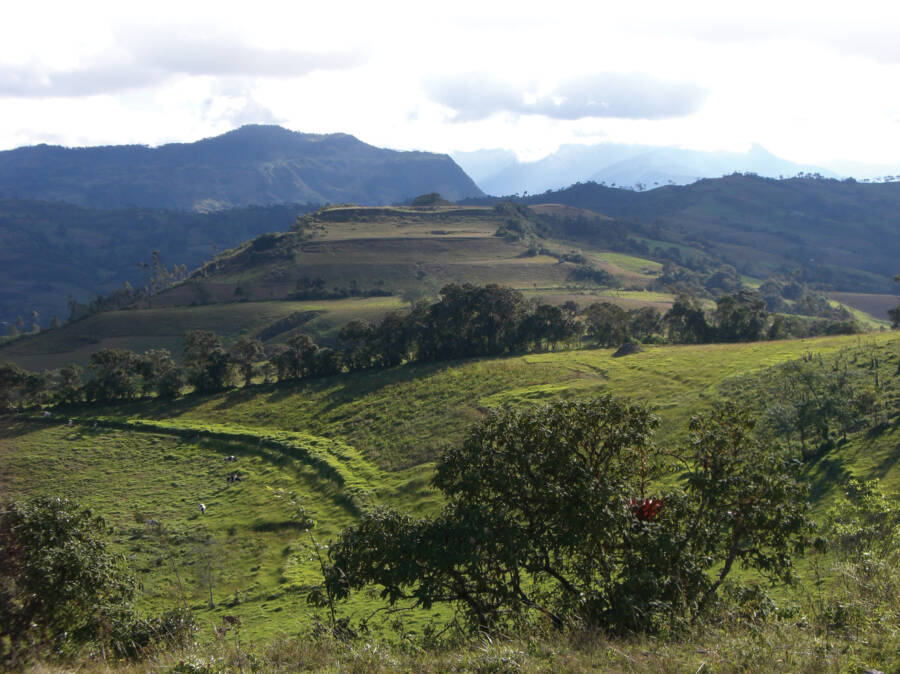
Bộ Văn hóa PeruMột nhóm các nhà khảo cổ học phát hiện ngôi mộ ở địa điểm Pacoampa ở miền bắc Peru.
While excavating the Pacopampa archaeological site in Peru, a team of archaeologists made an astounding discovery. After digging through six layers of ash and black earth, they uncovered the 3,000-year-old tomb of a person they now believe was a powerful religious figure.
Project leader Yuji Seki said the burial at Pacopampa was “very peculiar,” according to the BBC. The tomb itself was perfectly circular, measuring ten feet in diameter, while the grave was shallow at a depth of just 3.3 feet.
The skeleton was also fully intact and had been effectively protected against significant decay by the layers of ash and earth; strangely, it had been buried face down with its legs crossed. Archaeologists estimate the individual was buried around 1200 B.C.E., according to a press release by Peru’s Ministry of Culture.
While excavating the burial, archaeologists also found decorated ceramic bowls and two seals indicating the presence of ancient ritual body paint, traditionally used for people of elite standing. Researchers have now dubbed the skeleton the “Priest of Pacopampa” after the archaeological site, where the team has has been working since 2005.
“The find is extremely important because he is one of the first priests to begin to control the temples in the country’s northern Andes,” Seki explained.

Peru’s Ministry of CultureThese seals, found in the tomb, would have been used to stamp images on the painted body of the priest.
The Pacopampa site is located in the Cajamarca region of the Peruvian Andes, about 560 miles north of the capital of Lima and high up at an altitude of about 8,200 feet, Ancient Origins reports. The area is linked to pre-Incan cultures that likely spanned from 1200 to 500 B.C.E.
So far, archaeologists have discovered nine monumental buildings made from carved and polished stone at the Pacopampa site, believed to comprise a religious complex.
They have also uncovered three other tombs of religious leaders. The first was the “Lady of Pacopampa,” who was estimated to have been between 30 and 40 years old when she died in 900 B.C.E. She was buried with a collection of gold earrings, ceramic pots, and seashell necklaces.
The second tomb, found in 2015, housed two bodies and was perfectly intact, undisturbed by tomb robbers or artifact thieves (a significant problem at the Pacopampa site).
Both individuals were priests, and the tomb was adorned with several ornate artifacts. One individual was wearing a heavy gold necklace. The other held a black ceramic bottle with an engraved figure that had the body of a serpent and the head of a jaguar. The burial was thus named the “Tomb of the Serpent-Jaguar Priests.”
The tomb of the “Priest of Pacopampa” is believed to be older than those of the “Lady of Pacopampa” and the “Serpent-Jaguar Priests,” but a bit younger than the “Prince of the Pututos,” another burial which was was discovered last year and estimated to date back to 1200 B.C.E. or earlier.
The “Priest of the Pututos” was named for the peculiar objects with which he was buried. Pututos are an Andean wind instrument made out of seashells, and it’s believed this “Priest” may have used them in religious ceremonies.
These discoveries were all made under the Pacopampa Archaeological Project, an investigation launched in 2005 with the purpose of uncovering as much information as possible on the Pacopampan culture that predated the Inca. The team is comprised of archaeologists from the National Museum of Ethnology in Japan and from Peru’s National University of San Marcos.

Pacopampa Archaeological ProjectThe terraces of the Pacopampa archaeological site.
Archaeologists say the Pacopampa site is crucial to understanding ancient Peruvian culture. According to El País, the team suspects it may have a pilgrimage center, where ancient Peruvians came from across the region to participate in sacred religious rituals.